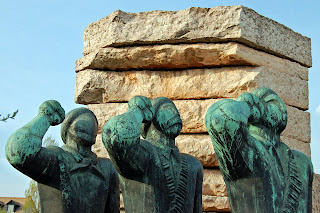This is the first in a long overdue series of photo blogs about my trip to
Budapest in April. What can I say about Budapest that hasn't been said already? It's one of the most beautiful cities in Europe, and a "two for one" at that. What I mean is that
Buda and Pest were (and for all intents and purposes are) separate cites long before they became one.
Buda was the predecessor to Pest, and was founded on the hilly west bank of the Danube. The Romans settled the area to the north before the Huns showed up. Hungarian kings fortified their palace on what is know as "Castle Hill", now a
UNESCO protected Heritage Site. Turks conquered it, Russians bombed it, but the tenacious Magyars are still there after a
millennium.
Pest is flat and lies on the East bank of the Danube. It developed much later and was primarily an agricultural area until the dawn of the industrial revolution, at which point it became a major commercial center. Pest is blessed with beautiful Austro-Hungarian and Art Nouveau architecture, old tree-lined boulevards and the fantastic
"City Park", which contains museums, monuments, mineral baths, a zoo, etc. etc.
That's it in a nutshell. I'll let Wikipedia do the rest. Let's get to the photos, shall we?


Atop the citadel on Gellert Hill. There used to be a large Russian soldier mounted below the woman with the palm leaf. You'll see him later... 
Another shot atop Gellert Hill.

The Danube and Pest from atop Gellert Hill. No, I didn't use the photo on the Wikipedia page. This one's mine. However, I'd have to think that there are many just like this one.
 Gotta train 'em early. Especially if the Russians decide to invade again. Gellert Hill citadel.
Gotta train 'em early. Especially if the Russians decide to invade again. Gellert Hill citadel. A lion on the Szechenyi Chain Bridge, with Parliament in the background.
A lion on the Szechenyi Chain Bridge, with Parliament in the background. 
A map of the fortified city atop Castle Hill in Buda.

A ride through the streets of old Buda.

No customers, no problem.

Outside Ruszwurm, a cafe and pastry shop dating from the early 19th century. They make great Apple Strudel.

St. Matthias Catherdral. Named for Matthias Corvinus, or known to the Romanians as Matai Corvin, Hungary's greatest warrior king.

Inside Matthias Catherdral.

Plenty of reading material available, no matter the language.
In a park atop Castle Hill. I love this shot.

Hungarian flags flying outside the prime minister's office.

Castle Hill, near the National Gallery.

View of the Szechenyi Chain Bridge and Pest from atop Castle Hill.


Terrace outside of the National Gallery, perched high atop Castle Hill.

Dusk on the Danube.

Castle Hill from the Pest side of the chain bridge.

Same thing here at night.
































































